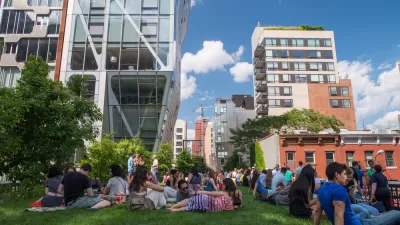A recent art project in Peru utilizes a robotic vehicle to trace a scale outline of a city into the empty desert, raising questions about urbanization in deserts and the formation of cities.
In this interview on We Make Money Not Art artist Rodrigo Derteano explains the project.
"I live and grew up in Lima. About 60% of the city today lies within the desert, most of it grew without any serious urban planning. It's a self-made metropolis, the second largest city built in the desert after Cairo. It grew from 1 million to 8 million people in less than 60 years. There's a lot of problems derived from this development in terms of sustainability and living standards which exacerbate the huge inequality of our society. The desert plays a big role in this regard. People living in desert areas of the city are usually poor and often have to pay more for water than those living in more centric (richer) areas. They also lack proper infrastructure and have much less public places and parks. For a long time, these areas were not considered part of the city by the ruling class and the authorities until they became the majority.
By drawing a gigantic map of a city onto the desert, the project not only seeks to draw attention to this facts, but questions our very concept of city, specially in regards to its environment. Lima is a sort of negation of the desert. Our model and ideal of city is very occidental, and does not adapt very well to its context. The desert is seen a kind of non-place, not a part of our living environment. In this sense, there's a sort of irony in using a robot to draw a city onto the desert, as if it would be drawing it on the surface of Mars (exploring the outer space for the possibility of urban life)."
FULL STORY: Ciudad Nazca, the robot tracing a city in the desert

Alabama: Trump Terminates Settlements for Black Communities Harmed By Raw Sewage
Trump deemed the landmark civil rights agreement “illegal DEI and environmental justice policy.”

Study: Maui’s Plan to Convert Vacation Rentals to Long-Term Housing Could Cause Nearly $1 Billion Economic Loss
The plan would reduce visitor accommodation by 25% resulting in 1,900 jobs lost.

Planetizen Federal Action Tracker
A weekly monitor of how Trump’s orders and actions are impacting planners and planning in America.

Wind Energy on the Rise Despite Federal Policy Reversal
The Trump administration is revoking federal support for renewable energy, but demand for new projects continues unabated.

Passengers Flock to Caltrain After Electrification
The new electric trains are running faster and more reliably, leading to strong ridership growth on the Bay Area rail system.

Texas Churches Rally Behind ‘Yes in God’s Back Yard’ Legislation
Religious leaders want the state to reduce zoning regulations to streamline leasing church-owned land to housing developers.
Urban Design for Planners 1: Software Tools
This six-course series explores essential urban design concepts using open source software and equips planners with the tools they need to participate fully in the urban design process.
Planning for Universal Design
Learn the tools for implementing Universal Design in planning regulations.
Caltrans
Smith Gee Studio
Institute for Housing and Urban Development Studies (IHS)
City of Grandview
Harvard GSD Executive Education
Toledo-Lucas County Plan Commissions
Salt Lake City
NYU Wagner Graduate School of Public Service



























